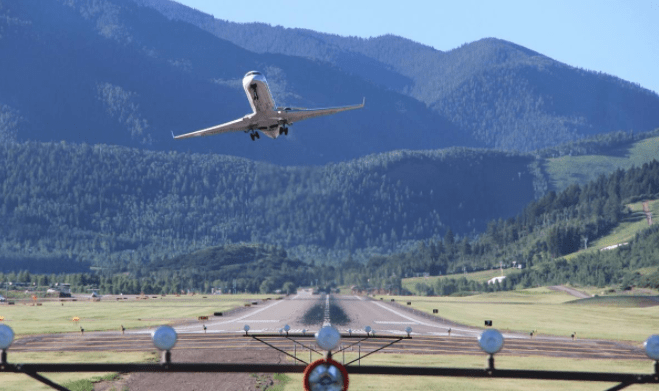Replacement Aircraft for Future Aspen Commercial Service Finally Identified
Aspen

Aspen

After years of discussion about which airplane will replace the aging fleet now serving Aspen’s airport, the most definitive answer yet finally came late last week.
The Brazilian-made Embraer E-175 is the new airplane, and while it has not yet been approved to fly in and out of Aspen’s challenging airport, nothing else is available to replace the Bombardier CRJ-700, which last rolled off its Canadian assembly line 12 years ago, officials said Friday.
“There’s not another (plane) of the same size as of yet,” said Dan Bartholomew, Aspen-Pitkin County airport director. “It will still come down to whether they can get that aircraft to operate in and out of here. It’s not a done deal, but it’s pretty close.
“In the near-term, this is the answer.”
In addition to highlighting the type of plane likely to serve future Aspen commercial airline passengers, Bartholomew told members of the Pitkin County Airport Advisory Board at their first meeting Thursday about the timeline for redeveloping the airport terminal and airfield, an upcoming paving project likely to close the facility for up to two weeks and whether new 5G phone service will be a problem for airplanes in Aspen.
“The most emergent need is the terminal,” Bartholomew said. “That aged terminal uses quite a bit of energy. It’s probably the best initial project.”
The news about the probable new jet that will supplant the CRJ-700 has been in the works for years as the tumultuous airline business has been roiled by outside forces, not the least of which has been the COVID-19 pandemic.
The E-175 carries 76 passengers, has an 85-foot-5-inch wingspan and a range of 1,800 miles. By comparison, the CRJ carries 69 passengers, spans 76-feet-3-inches and can travel a maximum distance of 1,611 miles, according to Bartholomew.
The Embraer’s newer technology, longer range and better reliability means it should cut down on cancellations and diversions, which are frequent in Aspen, and can circle a bit longer in attempting to land. The newer plane’s improved avionics allow it to fly into Aspen with lower “approach minimums” or in worse weather, he said.
However, the exact formula for the E-175’s relationship with Aspen’s airport — located at the back of a steep valley, jammed between a highway and a stark ridge with just one runway — has not yet been worked out.
The approach procedures are the issue, said Bill Tomcich, a consultant with a local alliance called Fly Aspen Snowmass representing the Aspen Skiing Co., the airport, the Aspen Chamber Resort Association and Snowmass Tourism.
The procedures for CRJ-700 don’t directly translate to the E-175, he said. New procedures for the E-175 have been developed for the Aspen-Pitkin County Airport, though they have yet to be tested or implemented, Tomcich said. Twelve to 18 months is a realistic timeframe for those procedures to be tested and the new planes to begin ferrying passengers to Aspen.
“But this is the only option (in the pipeline),” he said. “Nothing else is feasible to replace the CRJ-700. A lot of (work) is going in to try to make it work for our airport.”
In fact, Aspen’s airport is beginning the process of carving out at least two parking spaces for the wider-wingspanned E-175, Bartholomew said. The spaces won’t only be for E-175s, but the airport feels the need to remake the current commercial parking spaces to be able to accommodate the new planes, he said.
A new airfield and terminal for Aspen and Pitkin County — which has been talked about even longer than the type of new airplane that will fly in and out of it — also was part of Bartholomew’s presentation Thursday to new advisory board members.
A BOCC-appointed citizen board made a series of recommendations to commissioners in 2020 about what the new airport should emphasize. Board members accepted those recommendations in October 2020, though they were different than those approved by the Federal Aviation Administration during prior a three-year process.
That decision set back efforts to develop the project because the FAA must approve the new concepts and possibly conduct another environmental assessment study based on them.
In order to move forward, Bartholomew said the Vision Committee recommendations must first be codified into the facility’s Airport Layout Plan, which was last updated in 2015, before the FAA will fund any of it. Once that is done, the plan can be submitted to the FAA for approval. A big and possibly expensive decision hinges on whether the agency will merely revisit the former EA or conduct a new one.
Once that is done, airport officials can concentrate on designing a new terminal, followed by design of a new air traffic control tower, construction of those buildings and finally revamping of the airfield, Bartholomew said.
As for more-pressing, current projects, the airport is likely to be closed for up to two weeks in early May for airfield pavement repairs to the runway, taxiway and ramp, he said. Bartholomew initially told board members Thursday the closure would be a week, though a meeting Friday indicated it could be up to two weeks, he said.
The pavement will need more extensive repairs in 2024, Bartholomew said.
Finally, new 5G cellular technology won’t affect any systems at the Aspen airport.
“The FAA said it won’t affect any airport in Colorado,” he said. “None of the 5G antennas in Colorado are close enough to any navigational aids to impact any (airports) in the whole state.”
By: Jason Auslander I The Aspen Times I January 24, 2022